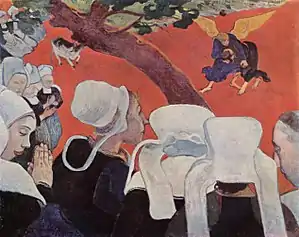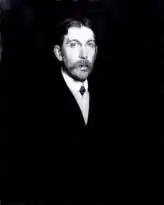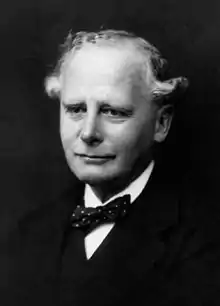Leeds Arts Club
The Leeds Arts Club was founded in 1903 by the Leeds school teacher Alfred Orage and Yorkshire textile manufacture Holbrook Jackson, and was probably one of the most advanced centres for modernist thinking in Britain in the pre-First World War period.
History
The Leeds Arts Club, founded by Leeds school teacher Alfred Orage and Yorkshire textile manufacture Holbrook Jackson, was an
.jpg.webp)
iconoclastic organisation that mixed radical socialist and anarchist politics with the philosophy of Friedrich Nietzsche, Suffragette Feminism, the spiritualism of the Theosophical Society and modernist art and poetry into a heady mixture. It had close associations with the Independent Labour Party, the co-operative movement and the early Fabian Society. At its weekly meetings it would often discuss the connections between art, spiritualism, philosophy and politics.[1]
Orage actively encouraged women members such as the suffragette and radical editor, Mary Gawthorpe, to participate in debates. Gawthorpe describes in her autobiography speakers such as Beatrice Farr, and how the debates led her to appreciate women's experience, such as her friend Ethel Snowdon, as well as pointing out the role of Alfred's wife Jean Orage, a textile artist, in challenging Orage to develop his theories and ideas.[2]
In 1907 Orage and Jackson left Leeds and moved to London to edit the hugely influential cultural and political journal The New Age. Following their departure the Arts Club came under the sway of Frank Rutter, the founder of the Allied Artists Association and newly appointed Director of Leeds City Art Gallery, and Michael Sadler, the new Vice-Chancellor of the University of Leeds. Under their leadership the Arts Club maintained its interest in the relationship between radical politics, spiritualism and art, but this was expanded to encompass early psychoanalysis and, most significantly, abstract art.
Rutter initially had plans to create a modern art collection at the Leeds City Art Gallery, but had been frustrated in this aim by "boorish" local councillors.[3] He co-founded the Leeds Art Collections Fund with Sadler, to help acquisitions and shows, among one in June 1913 of Post-Impressionism held at the Arts Club, which was reactivated by the new activity. The discussions there about contemporary art, and the presence of Rutter, had a significant influence on the thinking of Herbert Read (1893–1968), who turned 20 in December 1913.[4]

Using his personal links with Wassily Kandinsky in Munich, Sadler built up a remarkable collection of expressionist and abstract expressionist art at a time when such art was either unknown or dismissed in London, even by well-known promoters of modernism such as Roger Fry. Most notable in his collection was Kandinsky's abstract painting Fragment for Composition VII, of 1912,[5] which was in Leeds and on display at the Leeds Arts Club in 1913. He also owned Paul Gauguin's celebrated work "The Vision After the Sermon". According to Patrick Heron, Kandinsky even visited the Arts Club in Leeds before the First World War.[6]
Leeds Civic Trust commemorated the Leeds Arts Club by a blue plaque on number 8 Blenheim Terrace where it met 1908–1923, opposite the University of Leeds. The plaque was unveiled on 15 May 2012, by Ingrid Roscoe, Lord Lieutenant of West Yorkshire, and a speech was made by Tom Steele, author of Alfred Orage and The Leeds Arts Club. The plaque had been suggested by Ben Read, art historian and son of Herbert Read. The inscription is:
THE LEEDS ART CLUB A highly influential forum for the avant-garde in politics, philosophy, art and literature met here from 1908. Ground-breaking exhibitions included the 1913 Post-Impressionist show and Cubist and Futurist Art in 1914. Famous speakers included G.B. Shaw and W.B. Yeats. 1903-1923[7][8]
Influence
It has been argued by the art historian Michael Paraskos that the Leeds Arts Club was the closest England came to a genuine expressionist art movement. This is evidenced partly by the Arts Club's, artistic, philosophical and political interests, which mirror those seen in German expressionist art groups of the time, and through its direct links to Kandinsky in Germany. It also produced its own expressionist artists, including Jacob Kramer and Bruce Turner.[9]
It also was the seed ground from which the anarchist poet, art critic and art theorist Herbert Read emerged, and Read's basic dialectical theory of art, which became one of the main methods to understand modernism between the 1930s and 1960s, has its roots in the understanding of art expounded at the Leeds Arts Club.[10]
The influence of art the Arts Club also extended into later institutions in London. When Alfred Orage and Holbrook Jackson left Leeds in 1906 they moved to London and began editing the weekly cultural and political journal The New Age. As Tom Steele has argued, this was a self-conscious attempt to expand the reach of the philosophy developed at the Leeds Arts Club to a national audience. Under Orage and Jackson The New Age became, in Steele's words, 'the most influential journal of literature and politics in the country, with regular articles from established writers like G.K. Chesterton, George Bernard Shaw, Hillaire Belloc and Arnold Bennett, reviewing from Ezra Pound and Herbert Read, art criticism and theory from T.E. Hulme and illustrations from Wyndham Lewis, Jacob Epstein and others. It was the cradle of the modern avant-garde in Britain.' A number of these writers had given lectures at the Leeds Arts Club previously - or, like Read, were members - and Steele's argument is that the lively cultural debates that took place at the Leeds Arts Club under Orage and Jackson were effectively continued in the pages of The New Age.[11]
The Leeds Arts Club also became the model for Alfred Orage to establish a new arts club in 1906, this time in London, under the name of the Fabian Arts Group. As well as emulating the cultural, philosophical and political predilections of the Leeds Arts Club, the Fabian Arts Group was an attempt by Orage and others to influence the political outlook of the early Labour Party through one of its founding organisations, the Fabian Society.[12]
A third legacy of the Leeds Arts Club occurred in London in 1947, after the Second World War, when former Leeds Arts Club member, Herbert Read co-founded the Institute of Contemporary Arts, or ICA, again directly emulating the model, combining avant-garde culture, philosophical discussion and political mission, established by Orage and Jackson when they established the Leeds Arts Club.[13]
The Leeds Arts Club was also the starting point for the community theatre project that eventually grew to become the West Yorkshire Playhouse. This began in 1907 as an offshoot of the Leeds Arts Club, called the Leeds Playgoers' Society, and organised both performances of modern plays by writers such as Ibsen, Shaw and Chekov, and lectures on drama, which continued to be held in collaboration with the Leeds Arts Club.[14] This later evolved into the Leeds Playhouse, the forerunner to the West Yorkshire Playhouse.
Notes and references
- Tom Steele, Alfred Orage and the Leeds Arts Club 1893-1923 (Mitcham, Orage Press, 2009) 65f and passim
- Gawthorpe, Mary (1962). Up Hill to Holloway. Michigan. pp. 194–196.
- Tom Steele, Alfred Orage and the Leeds Arts Club 1893-1923 (Mitcham, Orage Press, 2009) 227
- Tom Steele, Alfred Orage and the Leeds Arts Club 1893-1923 (Mitcham, Orage Press, 2009) 218f
- Michael Saler, The Avant-Garde in Interwar England (New York: Oxford University Press, 1999) 52
- see Heron interview in B. Read and D. Thistlewood, Herbert Read: A British Vision of World Art, London 1993
- "Director's Blog May 2012 - What's New to the Trust". Leeds Civic Trust. Retrieved 3 June 2012.
- Crossen, John (June 2012). "Pioneering arts institution honoured: blue plaque for Leeds Arts Club". Leeds Civic Trust Newsletter: 1–2.
- Michael Paraskos, English Expressionism (Leeds: University of Leeds, unpublished Phd, 1997) passim
- David Thistlewood, 'Herbert Read: Formlessness and Form (London: Routledge, 1990) p. 30
- Tom Steele, 'From Gentleman to Superman: Alfred Orage and Aristocratic Socialism' in Christopher Shaw and Malcolm Chase (eds.), The Imagined Past: History and Nostalgia (Manchester: Manchester University Press, 1989) p.112
- Tom Steele, 'From Gentleman to Superman: Alfred Orage and Aristocratic Socialism' in Christopher Shaw and Malcolm Chase (eds.), The Imagined Past: History and Nostalgia (Manchester: Manchester University Press, 1989) p.112
- Nannette Aldred, 'A sufficient Flow of Vital Ideas: Herbert Read and the Flow of Ideas from the Leeds Arts Club to the ICA' in Michael Paraskos (ed.) Re-Reading Read: New Views on Herbert Read (London: Freedom Press, 2008) p.70
- The Stage Yearbook 1918 (London: The Stage Publications, 1918) p.75; Andrew Thacker, 'That Trouble: Regional Modernism and Little Magazines' in Neal Alexander (ed.), Regional Modernisms (Edinburgh: Edinburgh University Press, 2013) p.27


